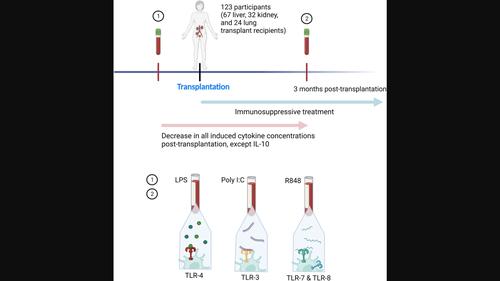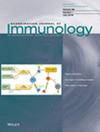实体器官移植前后toll样受体配体诱导的细胞因子浓度的差异:一项临床前瞻性观察队列研究
IF 4.1
4区 医学
Q2 IMMUNOLOGY
引用次数: 0
摘要
需要可靠的方法来评估实体器官移植(SOT)后的免疫功能,以指导免疫抑制的剂量。我们假设toll样受体配体诱导的细胞因子浓度会在移植后由于使用免疫抑制药物而降低。此外,我们假设在移植后由于潜在的免疫倾向而发生急性排斥反应的受者中,移植前诱导的细胞因子浓度会更高。我们旨在通过struculture©(一种标准化的免疫测定方法)研究SOT受者在SOT前和SOT后3个月的toll样受体配体诱导的细胞因子浓度,并探讨与甲基强的松龙治疗的急性排斥反应的关系。我们进行了一项前瞻性、观察性队列研究,包括123名参与者(67名肝脏、32名肾脏和24名肺移植受者)。用(A)脂多糖(LPS), (B)雷西喹莫特,(C)多肌苷:多胞酸(Poly I:C)和(D)空白对照刺激全血22小时。用Luminex检测细胞因子浓度(TNF-α、IL-1β、IL-6、IL-8、IL-10、IL-12p40、IL-17A、IFN-α和IFN-γ)。30名参与者在sot后中位9天(IQR 5-17)出现甲泼尼龙治疗的急性排斥反应。我们发现,除了lps诱导和Poly I: c诱导的IL-10外,所有诱导的细胞因子浓度都在sot后下降。移植前诱导的细胞因子浓度在有或没有急性排斥反应的受体中没有差异。综上所述,除抗炎细胞因子IL-10外,sot后所有刺激诱导的细胞因子浓度均下降。重要的是,发生早期急性排斥反应的受体在sot前诱导的细胞因子浓度没有差异。因此,在临床环境中使用SOT标准化检测是可行的,并且可以提供SOT后免疫功能的重要信息。本文章由计算机程序翻译,如有差异,请以英文原文为准。

Differences in toll-like receptor ligand-induced cytokine concentrations before and after solid organ transplantation: A prospective, observational cohort study in a clinical setting
Reliable methods to assess immune function after solid organ transplantation (SOT) are needed to guide dosing of immunosuppression. We hypothesized that toll-like receptor ligand-induced cytokine concentrations would decrease post-transplantation due to the use of immunosuppressive medication. Furthermore, we hypothesized that induced cytokine concentrations pre-transplantation would be higher in recipients with episodes of acute rejection post-transplantation due to underlying immunological dispositions. We aimed to investigate toll-like receptor ligand-induced cytokine concentrations by TruCulture©, a standardized immunoassay, in SOT recipients before and 3 months after SOT and explored associations with methylprednisolone-treated acute rejections. We conducted a prospective, observational cohort study including 123 participants (67 liver, 32 kidney and 24 lung transplant recipients). Whole blood was stimulated for 22 h with: (A) Lipopolysaccharide (LPS), (B) Resiquimod, (C) Polyinosinic:polycytidylic acid (Poly I:C) and (D) a blank control. Cytokine concentrations (TNF-α, IL-1β, IL-6, IL-8, IL-10, IL-12p40, IL-17A, IFN-α and IFN-γ) were measured by Luminex. 30 participants developed methylprednisolone-treated acute rejection at a median of 9 days (IQR 5–17) post-SOT. We found that all induced cytokine concentrations decreased post-SOT except from LPS-induced and Poly I:C-induced IL-10. The induced cytokine concentration pre-transplantation did not differ in recipients with or without acute rejection. In conclusion, the induced cytokine concentrations decreased for all stimuli post-SOT, except the anti-inflammatory cytokine IL-10. Importantly, recipients developing early acute rejection did not differ in induced cytokine concentrations pre-SOT. Thus, the use of a standardized assay in SOT is feasible in a clinical setting and may provide important information on the immune function post-SOT.
求助全文
通过发布文献求助,成功后即可免费获取论文全文。
去求助
来源期刊
CiteScore
7.70
自引率
5.40%
发文量
109
审稿时长
1 months
期刊介绍:
This peer-reviewed international journal publishes original articles and reviews on all aspects of basic, translational and clinical immunology. The journal aims to provide high quality service to authors, and high quality articles for readers.
The journal accepts for publication material from investigators all over the world, which makes a significant contribution to basic, translational and clinical immunology.

 求助内容:
求助内容: 应助结果提醒方式:
应助结果提醒方式:


